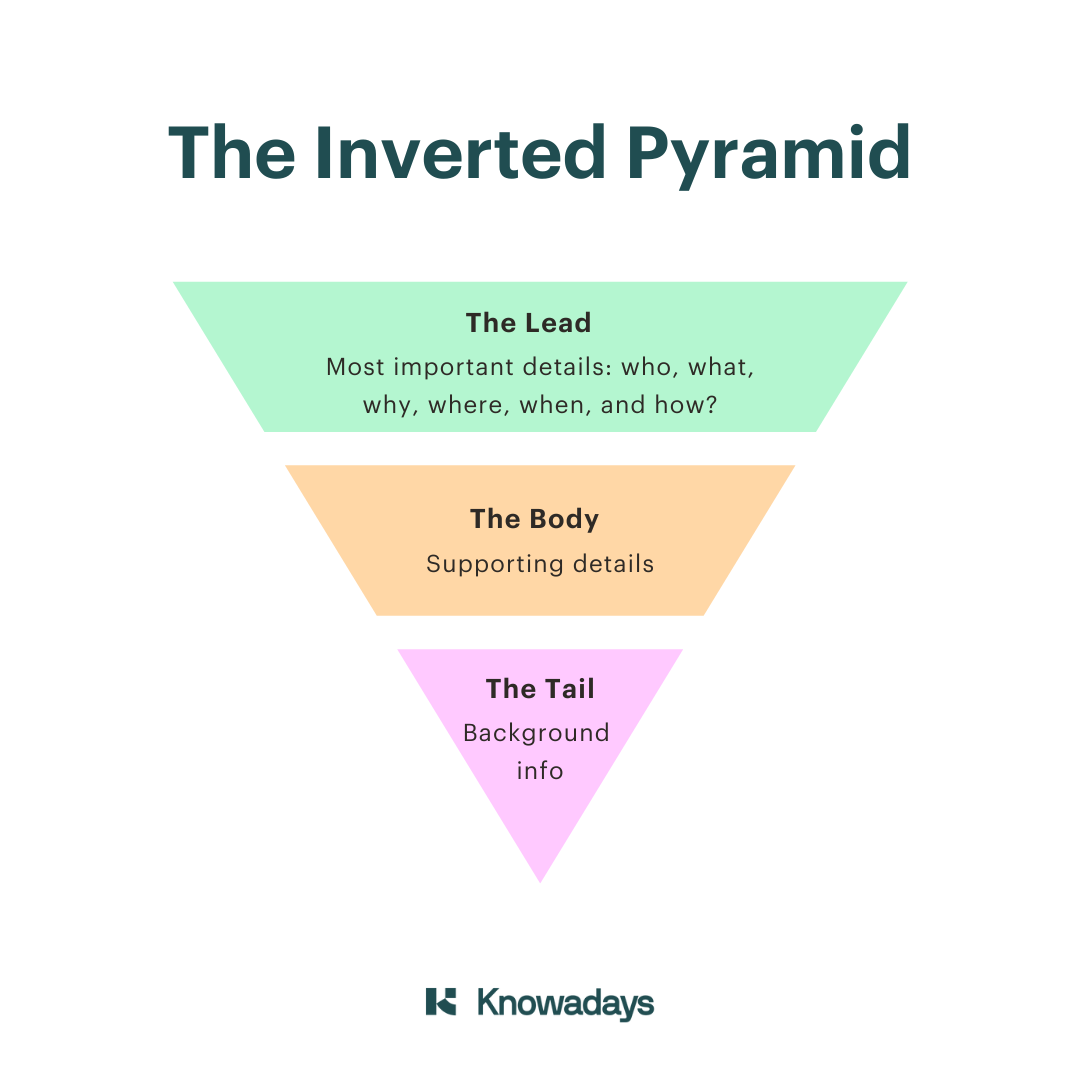
The Inverted Pyramid in Journalism
The inverted pyramid is a handy tool used by journalists and business writers to structure their work. Understanding the inverted pyramid and how it’s used will help you to edit this type of writing.
In this post, we explain the basics of the inverted pyramid so that you can use it to help assess your client’s work.
What Is the Inverted Pyramid?
The inverted pyramid is a structure commonly used in journalism and business writing to create articles and reports that are easy to read and follow. It is also commonly used for web copy, such as blog posts and landing pages.
The format originated from the rise of the telegraph and its use in news reporting, particularly during the Civil War, when there was a significant need to quickly and concisely communicate essential information. The Associated Press, founded during this period, became especially known for its tightly written, inverted pyramid style.
The inverted pyramid consists of three main components:
● The lead
● The body
● The tail
The idea is that the most important information is given in the opening of the article (the lead), followed by the finer details in the main section (the body), before tapering to less important background information toward the end (the tail).

Benefits of Using the Inverted Pyramid
There are several benefits (for writers and editors) to using the inverted pyramid format:
- Quickly capture your reader’s attention: For busy professionals or readers scanning for specific answers, the format ensures they can quickly find the information they need without wading through fluff or excessive background details.
- Support multiple formats and industries: This format is versatile, adapting easily to a wide range of content types across various sectors. For instance, a blog post can be quickly repurposed into a social media snippet or newsletter introduction.
- Enhance readability and skimmability: Many readers skim online content. The inverted pyramid makes it easy to grasp the main idea without needing to read the entire piece, ensuring your key message is understood. This is particularly beneficial for mobile readers, who are less likely to scroll through long paragraphs.
- Help logically organize content: Its structured, hierarchical framework guides writers through the logical flow of information, making it easier to build clear and impactful content.
- Boost search engine rankings: Search engines prioritize content that answers user queries quickly. Placing crucial information at the top helps search engines understand your content’s relevance right away, potentially improving rankings.
- Reduce bounce rates: When readers find value immediately, they’re more likely to stay on the page and continue reading. The inverted pyramid increases the chances of engagement by front-loading the most critical insights.
The inverted pyramid can also be ideal for writers on a deadline – by leading with the main point, you can quickly establish the purpose of your content and then fill in the relevant supporting details around it.
Drawbacks to Using the Inverted Pyramid Format
While there are several advantages to using the inverted pyramid, there are also a few drawbacks:
- Limit narrative engagement: Since the format prioritizes efficiency and front-loads critical information, it can lack the storytelling elements that create emotional resonance and connection with the reader. For creative writing, brand storytelling, or narrative-driven content, this structure can feel too rigid and formulaic.
- Be unsuitable for certain content types: Content that relies on suspense, chronological storytelling, or deep narrative arcs (such as case studies, white papers, or long-form storytelling) often suffers under this format. In these cases, revealing the main point too early can diminish the impact.
- Oversimplify complex topics: When dealing with layered or nuanced subjects, the inverted pyramid’s structure can sometimes oversimplify critical details. The need to prioritize main points upfront may prevent deeper exploration of interconnected ideas.
- Be a challenge for persuasive writing: In marketing or persuasive writing, building a logical argument or guiding the reader through a journey often requires a more gradual reveal of information. The inverted pyramid’s straightforward approach can sometimes undermine the gradual buildup needed for persuasion.
- Lead to redundancy in long-form content: In longer articles or reports, front-loading all key information can make the rest of the content feel repetitive, as supporting details may seem redundant if the reader already knows the main points.
- Result in a flat tone: Because the format emphasizes clarity and brevity, it can sometimes lead to a flat or monotonous tone, making it harder to maintain reader engagement throughout the piece.
Editing and the Inverted Pyramid
As an editor, you can use the inverted pyramid to check that your client’s work is structured appropriately. But remember to keep the target audience and tone in mind, too.
For example, the target audience and tone for a serious news piece are likely to be very different from those for a punchy satirical piece. While both may use the same inverted pyramid format, the news piece will be far more formal and objective. For an example of this in action, compare this PBS article on an earthquake in Morocco with this one from The Onion: Man Resolves To Read The Wikipedia Tabs He Already Has Open Before Starting New Ones.
Let’s take a closer look at the elements of the inverted pyramid from an editing perspective.
1. The Lead
The lead (or lede) is the opening line or paragraph of a piece of journalism. It should answer the who, what, why, where, when, and how of the subject matter in no more than one or two sentences. This way, the reader is immediately provided with everything they need to understand the main point of a news story or subject. This makes it easy for skim readers to pick up on the key details while also encouraging them to read further for additional information.
For instance, take a look at this article from the Associated Press on a Louisiana coastal restoration project; all the essential information is immediately outlined in the first paragraph, with the rest of the article providing relevant supporting details about the topic.
When editing a journalistic article or piece of web copy, you should check that your client has included all the key details of the story in the lead. Ensure the writer has clearly and concisely communicated all the necessary information (e.g., the who, what, and why) without any irrelevant tangents or unnecessary jargon.
You should also avoid “burying the lead” – hiding key facts deeper in the piece.
2. The Body
This is the main section of the article. It provides supporting details about the story or subject.
The body may also contain:
● The author’s argument
● Supporting evidence
● Quotes and commentary
For an example of well-structured body text within the inverted pyramid structure, check out this Apple report detailing their quarterly results. While the introduction gives all the most essential information, the body paragraph expands on the content with quotes from executives and supporting figures.
In this section, you’ll want to make sure your client has expanded on the information given in the lead without introducing new essential information or going into so much detail that the main point of the article or story is lost. Check that there is enough context provided in this section to support the main ideas without losing the reader’s attention.
When editing, you should also verify that any quotes are properly attributed and that facts or figures are relevant and up to date.
3. The Tail
The tail is the final paragraph of an article. Any background information or additional insights that are helpful (but not essential) to understanding the story should be included here.
Depending on the purpose of your client’s work, the tail may also include information about the author, advice on where to go for further reading on the subject, or a call to action. For instance, in this NASA article on Voyager 1, the tail concludes with background information on the launch of the two Voyager spacecraft.
Again, you should check that your client hasn’t provided any new essential information or surprise twists to the story here. Avoid surprising the reader with essential facts that disrupt the flow. If your client’s text introduces critical numbers or shocking facts here, you’ll want to move them up to the lead.
One way to make sure your client has used the inverted pyramid correctly is to remove the tail. If you find that the rest of the article no longer makes sense or that it presents an incomplete story, you might advise your client to move pertinent details up into the body or even into the lead.
Editing Checklist: The Inverted Pyramid
Below is a checklist for each element of the inverted pyramid to use as a reference point when editing:
- Does the first paragraph answer the essential questions (who, what, where, when, why, and how)?
- Is the lead clear and concise?
- Does the lead immediately grab the reader’s attention?
- Is there any vital information missing or hidden deeper in the content?
- Does the body of the text expand logically on the lead without adding any off-topic or irrelevant details?
- Are transitions between paragraphs smooth and logical?
- Is each paragraph focused and on topic?
- Are quotes or factual evidence effectively placed throughout the content to support the main argument?
- Does the tail avoid introducing new crucial information and instead focus on wrapping up the content (such as by providing relevant background or including an engaging call to action)?
- If you remove the final paragraph (the tail), does the piece still stand on its own?
Becoming An Editor
Reading a host of different types of content with a critical eye can be a valuable exercise for editors in training. For extra practice, try out our inverted pyramid editing checklist on some real pieces of content. Use it to sharpen your editorial instincts and check if you can spot weak ledes, redundant details, and buried essential facts.
With a module dedicated to business writing, our Becoming An Editor course can put you on track to launching your career as a business editor. Sign up for some free lessons and see where it takes you!





Your email address will not be published.